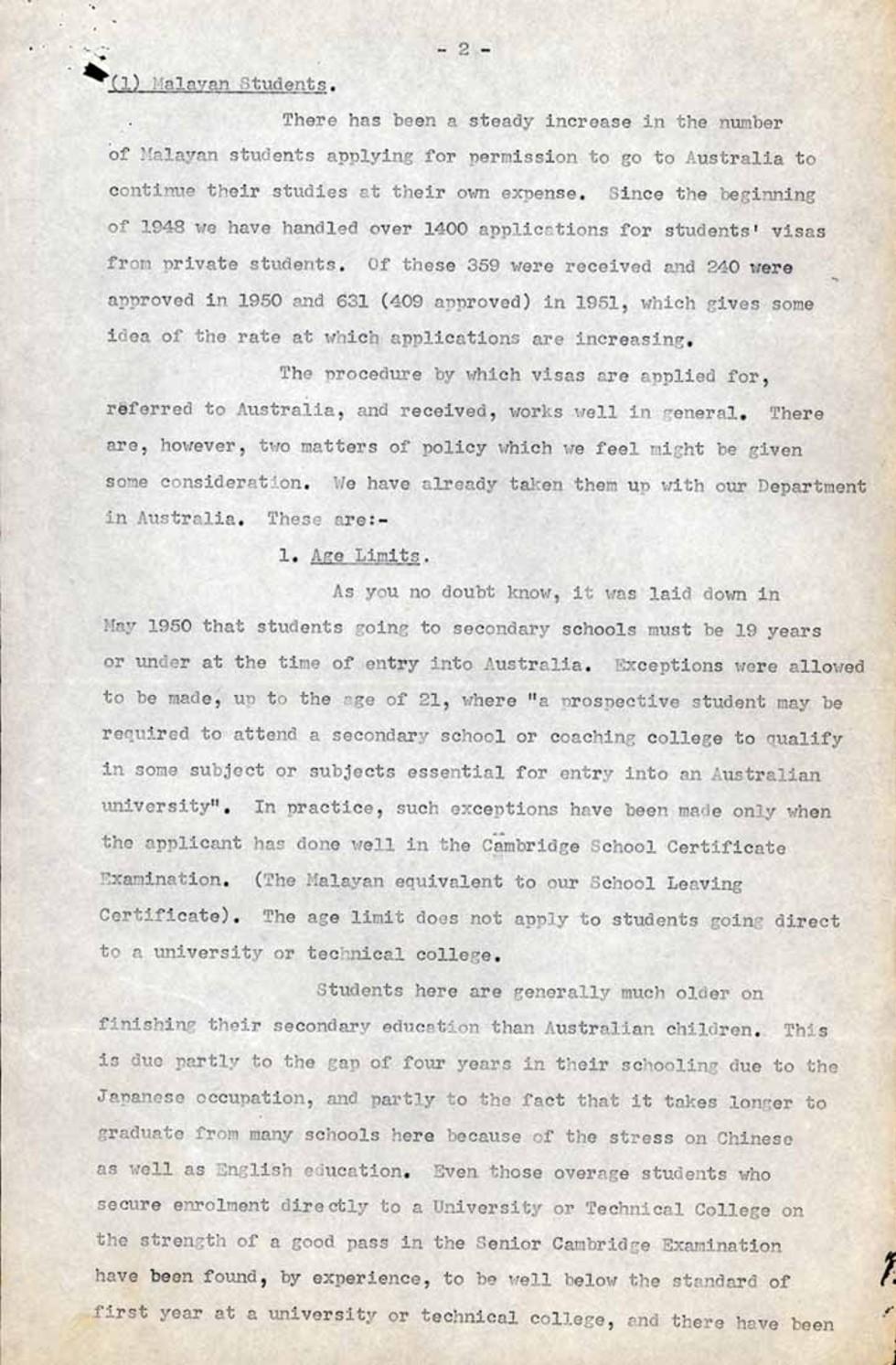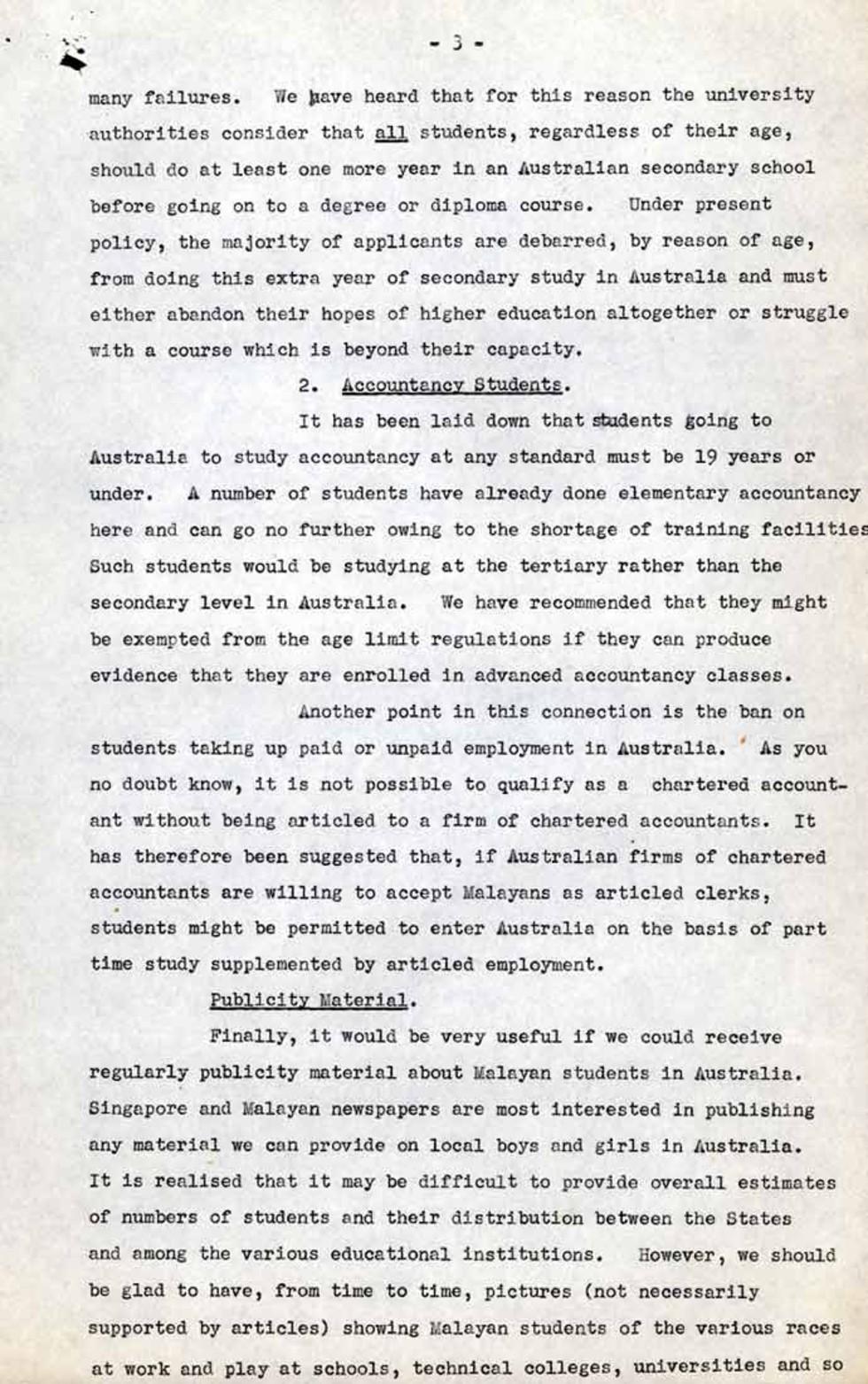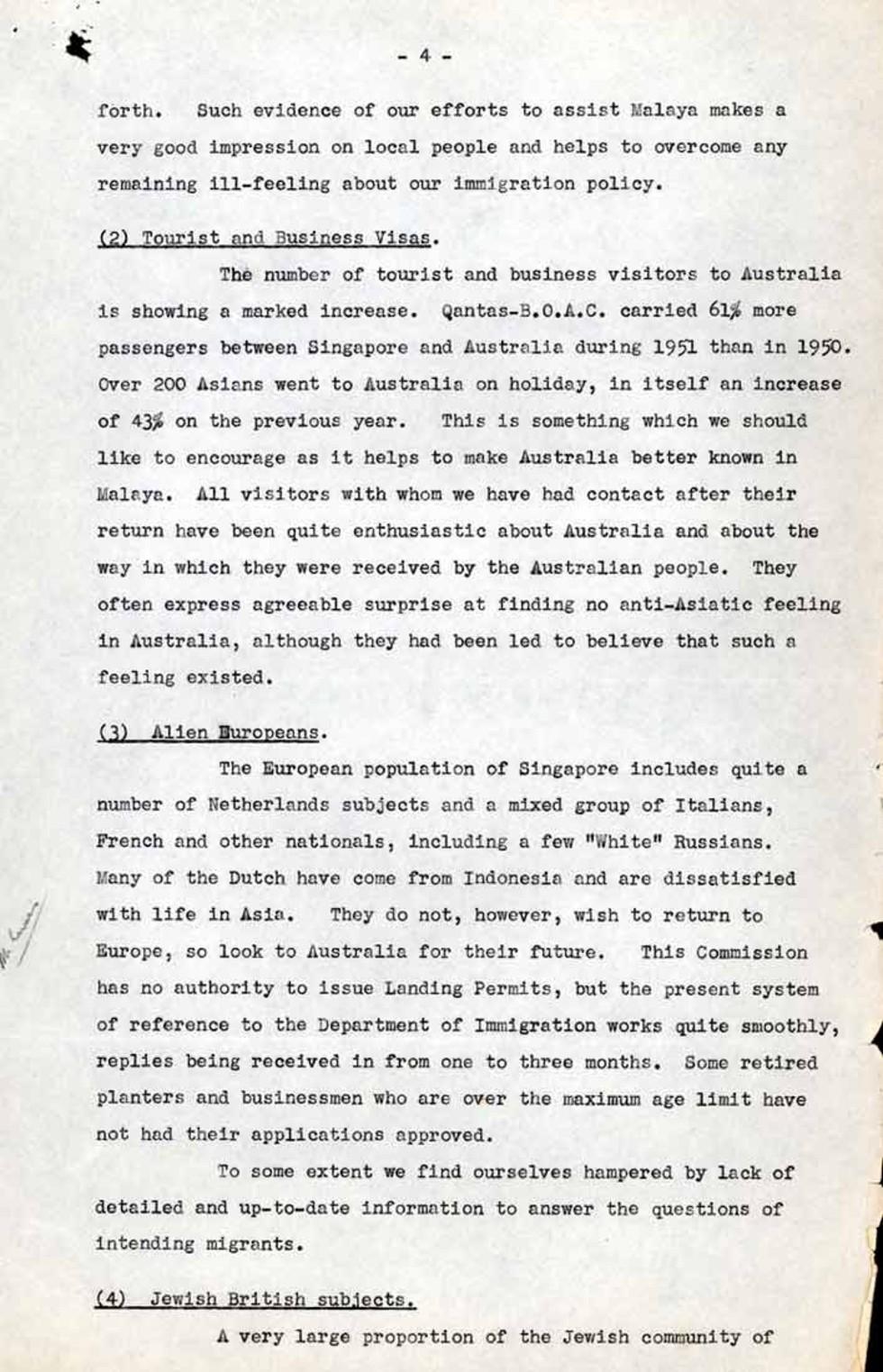





Aboriginal and Torres Strait Islander people should be aware that the National Archives' website and collection contain the names, images and voices of people who have died.
Some records include terms and views that are not appropriate today. They reflect the period in which they were created and are not the views of the National Archives.







[Page 1]
[Handwritten] Mr [unclear] to see these notes for Singapore High Commission office [Signature] 24/5
For the Minister for Immigration. [underlined]
Following the action of the Australian Government in 1948 in requiring certain Malay seamen to leave Australia although these men had married Australian women of European race, hostility in Singapore to the Australian Immigration policy reached a high point and continued through 1949.
While this active hostility has now almost completely subsided it is nevertheless essential that the utmost care be taken to ensure that the latent antipathy to any policy which might be constructed as racial should not be aroused. Members of the Singapore Legislative Council are particularly sensitive and any ambiguous statement or action might well do great damage to our friendly relations with the local political leaders.
The interest which is taken here is illustrated by the publicity which was given recently to the visit to Australia of Sgt. Gamboa. Favourable publicity has also been given to the decision to permit Mrs. Osman, an Australian woman married to a Malay, to return to Australia with his wife and child because of his outstanding record in the Borneo underground during the war. Such decisions as these do much to convince the Asians that Australia’s Immigration Policy is not unreasonable.
Much of the work of the Commission is concerned with the processing of applications by students. The many students now going to Australia provide a valuable opportunity for Australia to make friends in Malaya and indirectly to influence the future of the country.
I attach notes as follows on types of migration from Singapore to Australia.
[Handwritten tick] (1) Students. [Handwritten] 52/1335
(2) Tourists and Business Visitors.
(3) Alien Europeans.
[Handwritten tick] (4) Jewish British Subjects. [Handwritten] 51/213
[Handwritten tick] (5) Eurasian British Subjects. [Handwritten] 5 [unclear]/2/846
[Page 2]
- 2 -
(1) Malayan Students.
There has been a steady increase in the number of Malayan Students applying for permission to go to Australia continue their studies at their own expense. Since the beginning of 1948 we have handled over 1400 applications for students’ visas from private students. Of these 359 were received and 240 were approved in 1950 and 631 (409 approved) in 1951, which gives some idea of the rate at which applications are increasing.
The procedure by which visas are applied for, referred to Australia, and received, works well in general. There are, however, two matters of policy which we feel might be given some consideration. We have already taken them up with our Department in Australia. These are:-
1. Age Limits. [Underlined]
As you no doubt know, it was laid down in May 1950 that students going to secondary schools must be 19 years or under at the time of entry into Australia. Exceptions were allowed to be made, up to the age of 21, where “a prospective student may be required to attend a secondary school or coaching college to qualify in some subject or subjects essential for entry into an Australian university”. In practice, such exceptions have been made only when the applicant has done well in the Cambridge School Certificate Examination. (The Malayan equivalent to our School Leaving Certificate). The age limit does not apply to students going direct to a university or technical college.
Students here are generally much older on finishing their secondary education than Australian children. This is due partly to the gap of four years in their schooling due to the Japanese occupation, and partly to the fact that it takes longer to graduate from many school here because of the stress on Chinese as well as English education. Even those overage students who secure enrolment directly to a University or Technical College on the strength of a good pass in the Senior Cambridge Examination have been found, by experience, to be well below the standard of first year at a university or technical college, and there have been
[Page 3]
- 3 -
many failures. We have heard that for this reason the university authorities consider that all [underlined] students, regardless of their age, should do at least one more year in an Australian secondary school before going on to a degree or diploma course. Under present policy, the majority of applicants are debarred, by reason of age, from doing this extra year of secondary study in Australia and must either abandon their hopes of higher education altogether or struggle with a course which is beyond their capacity.
2. Accountancy Students. [Underlined]
It has been laid down that students going to Australia to study accountancy at any standard must be 19 years or under. A number of students have already done elementary accountancy here and can go no further owing to the shortage of training facilities. Such students would be studying at the tertiary rather than the secondary level in Australia. We have recommended that they might be exempted from the age limit regulations if they can produce evidence that they are enrolled in advanced accountancy classes.
Another point in this connection is the ban on students taking up paid or unpaid employment in Australia. As you no doubt know, it is not possible to qualify as a chartered account-ant without being articled to a firm of chartered accountants. It has therefore been suggested that, if Australian firms of chartered accountants are willing to accept Malayans as articled clerks, students might be permitted to enter Australia on the basis of part time study supplemented by articled employment.
Publicity Material. [Underlined]
Finally, it would be very useful if we could receive regularly publicity material about Malayan students in Australia. Singapore and Malayan newspapers are most interested in publishing any material we can provide on local boys and girls in Australia. It is realised that it may be difficult to provide overall estimates of numbers of students and their distribution between the States and among the various educational institutions. However, we should be glad to have, from time to time, pictures (not necessarily supported by articles) showing Malayan students of the various races at work and play at schools, technical colleges, universities and so
[Page 4]
forth. Such evidence of our efforts to assist Malaya makes a very good impression on local people and helps to overcome any remaining Ill-feeling about our immigration policy.
(2) Tourist and Business Visas. [Underlined]
The number of tourist and business visitors to Australia is showing a marked increase. Qantas-B.O.A.C. carried 61% more passengers between Singapore and Australia on holiday, in itself an increase of 43% on the previous year. This is something which we should like to encourage as it helps to make Australia better known in Malaya. All visitors with whom we have had contact after their return have been quite enthusiastic about Australia and about the way in which they were received by the Australian people. They often express agreeable surprise at finding no anti-Asiatic feeling in Australia, although they had been led to believe that such a feeling existed.
(3) Alien Europeans. [Underlined]
The European population of Singapore includes quite a number of Netherlands subjects and a mixed group of Italians, French and other nationals, including a few “White” Russians. Many of the Dutch have come from Indonesia and are dissatisfied with life in Asia. They do not, however, wish to return to Europe, so look to Australia for their future. This Commission has no Authority to issue Landing Permits, but the present system of reference to the Department of Immigration works quite smoothly, replies being received in from one to three months. Some retired planters and businessmen who are over the maximum age limit have not had their applications approved.
To some extent we find ourselves hampered by lack of detailed and up-to-date information to answer the questions of intending migrants.
(4) Jewish British Subjects.
A very large proportion of the Jewish community of
[Page 5]
- 5 -
Singapore (about 800 persons) are hoping at some time to settle in Australia. The community is for the most part Middle Eastern, the families having come to Singapore from Iraq. Individuals are swarthy, speak English with a distinctive intonation even though born in Singapore, and most are orthodox in their religion. Standards of living range from the prosperous to middle class, but are on European rather than Asian level.
With very few exceptions all applications submitted by members of the community for permission to enter Australia have been disallowed. Unfortunately it has not always been easy for members of the community to understand why their own applications have not been approved when a favourable reply has been received by an acquaintance without apparently any greater claim. Further, most of the applicants have close relatives already permanently resident in Australia.
Recently, the President of the Jewish Welfare Board, Mr. David Marshall, through whom applications are in many cases channelled, approached us to express his concern at the refusals and to request advice as to the general principles on which the applications are accepted or refused. We have acknowledged the letter and requested instructions. Copies of our exchange of correspondence with Mr. Marshall are attached as it is possible that he may seek and interview with you during your stay in Singapore.
(5) Eurasians. [Underlined]
Like the members of the Jewish community, many Eurasians look forward to a future in Australia. The Eurasian, particularly he who is predominantly European in background, remembers that during the war with Japan his position was most difficult and he fears that there will be no future for his children in a country which is controlled by Asians.
The Eurasian community, which numbers about 10,000, is essentially middle-class, its members for the most part being teachers, civil servants, senior clerks and supervisors, and
[Page 6]
- 6 –
professional men. Socially, it falls broadly into three categories
(1) The Ceylon (Dutch) Burghers.
(2) The “Portuguese” Eurasians originally from Malacca
(3) English Eurasians and Anglo-Indians
The first two groups find it impossible to trace their racial origin. The Ceylon Burgher claims to be European and can produce a record of his lineal decent, but this is a most incomplete document and is of little use for our purposes. The Portuguese Eurasians whose families date back in many cases to the 15th Century have even less record of their ancestry as any records which might have existed were destroyed during the Japanese occupation. Generally speaking, members of these two groups marry only within their own group or occasionally with Europeans.
The members of the third group are of more recent Eurasian origin and have less difficulty in tracing their racial background, although the destruction of records during the war again presents many of them with insuperable problems.
Our present requirements are that a person should produce documentary evidence that he is 75% European in origin racially and be predominantly European in speech, dress and way of life. Groups (1) and (2) above and many of group (3) are quite unable to fulfil the requirement that they produce documentary evidence of racial background and are therefore barred from entering Australia unless a special case can be made out for them on the grounds of their European appearance.
During 1951 approximately 50 applications were received, representing some 150 persons. Of these about half the applications were approved. All the applicants were predominantly European in racial origin.
Notes for the Minister for Immigration.
Learn how to interpret primary sources, use our collection and more.
